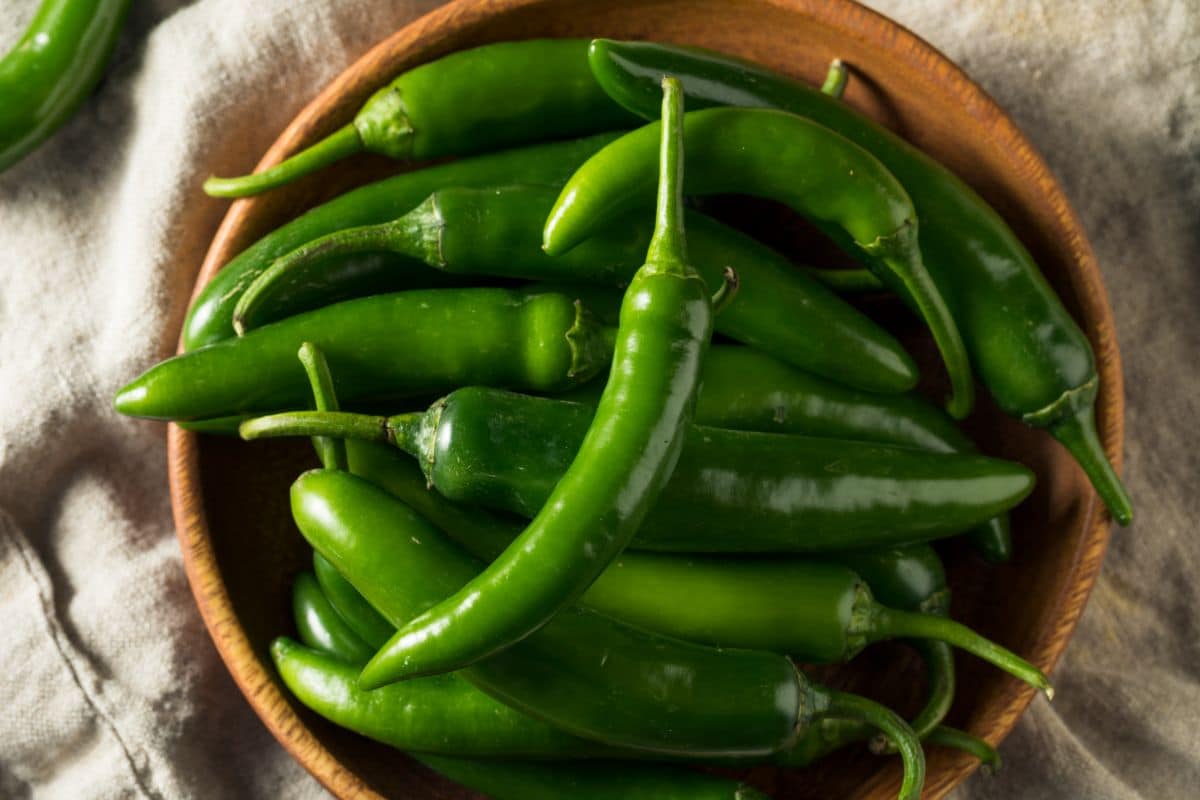If you enjoy spicy food, you’re likely familiar with the many types of peppers available on the market. One of the lesser-known varieties that deserves a spot in your culinary repertoire is the Serrano pepper.

Originally from the mountainous regions of Mexico, these small, slender peppers pack a punch of heat that is sure to delight your taste buds. But the Serrano pepper isn’t just about heat; it also boasts a complex flavor profile that adds depth and character to any dish.
Whether you’re looking to spice up your salsa, give your marinade some kick, or add some heat to your chili, Serrano peppers are a versatile ingredient that can take your cooking to the next level. In this article, we’ll dive deep into all things Serrano pepper.
We’ll explore the origin and history of this fiery little pepper, examine its heat level and nutritional value, and provide tips and tricks for incorporating it into your cooking.
So, whether you’re a seasoned pro or a curious beginner, keep reading to learn all about Serrano peppers and their delicious uses.
What Are Serrano Peppers?
Serrano peppers are a popular kind of pepper that first originated in the mountainous regions of Mexico. They are named after the Sierra Mountains, where they are traditionally grown.
These small, slender peppers typically range in length from 1-4 inches and are bright green when immature, turning to red, brown, orange, or yellow as they mature.
Serrano peppers have a heat level that ranges from moderately hot to very hot, depending on the individual pepper and its maturity. In addition to their heat, Serrano peppers have a complex flavor profile that is often described as bright, crisp, and slightly citrusy.
They are commonly used in Mexican and Tex-Mex cuisine, but their versatility makes them a popular ingredient in a variety of dishes, from salsas and hot sauces to soups, stews, and marinades.
History & Origin Of Serrano Peppers
The Serrano pepper has a rich history and cultural significance in Mexico, where it originated.
It is believed that the pepper has been cultivated in the mountainous regions of Mexico for thousands of years, and it has been an important ingredient in traditional Mexican cuisine for just as long.
The word “serrano” means “from the mountains” in Spanish, and the pepper gets its name from the Sierra Mountains, where it is traditionally grown.
The first recorded mention of the Serrano pepper in historical documents dates back to the 16th century, when it was described by Spanish explorers and chroniclers.
Over the centuries, the Serrano pepper has become an integral part of Mexican cuisine, used in everything from salsas and guacamole to tamales, enchiladas, and mole sauces.
It has also been exported to other parts of the world, where it has gained popularity in various international cuisines. Today, Serrano peppers are widely grown throughout Mexico, as well as in other countries across the world, such as Spain, the United States, and China.
They remain a beloved ingredient in Mexican cuisine and are enjoyed by people all over the world for their unique flavor and heat.
How Hot Are Serrano Peppers?
Serrano peppers are considered a moderately to very hot chili pepper, with a heat level that can range from 10,000 to 23,000 Scoville heat units (SHU) on the Scoville scale.
The heat level of a Serrano pepper can vary depending on its maturity, with fully mature peppers typically being hotter than immature ones.
For comparison, a jalapeño pepper, another popular chili pepper, typically has a heat level of 2,500 to 8,000 SHU. So, Serrano peppers are generally hotter than jalapeños.
It’s worth keeping in mind that the spiciness of a Serrano pepper can also vary based on the individual pepper and the growing conditions.
Additionally, the heat of a pepper can be affected by the way it is prepared and cooked. Removing the seeds and membranes of a Serrano pepper can help to reduce its heat level, while cooking can intensify its spiciness.
Different Types Of Serrano Peppers
There is generally only one type of Serrano pepper, but there can be variations in the color, size, and heat level of the peppers depending on where they are grown and other factors.
While green Serrano peppers are the most common, the peppers may also come in other colors as they mature, such as red, brown, orange, and yellow.
The color of a Serrano pepper can also affect its flavor, with some people preferring the taste of red Serrano peppers over green ones.
In terms of size, Serrano peppers typically range in length from 1-4 inches, with some peppers being longer or shorter depending on the individual plant.
Finally, as mentioned earlier, the heat of Serrano peppers can vary from moderately hot to very hot, with a range of 10,000 – 23,000 SHU.
The heat of a Serrano pepper can also depend on the individual pepper and its maturity, with fully mature peppers typically being hotter than immature ones.
Overall, while there may not be multiple types of Serrano peppers, the variations in color, size, and heat level can provide different flavor profiles and options for cooking with this versatile pepper.
What Do Serrano Peppers Taste Like?

Serrano peppers have a distinct and complex flavor profile that is often described as bright, crisp, and slightly citrusy. They have a fresh, grassy taste with hints of green apple and a subtle earthiness that makes them a popular ingredient in a variety of dishes.
When compared to other chili peppers, such as jalapeños or habaneros, Serrano peppers are generally considered to be hotter than jalapeños but milder than habaneros. However, it’s worth noting that heat perception is subjective and can vary depending on the individual.
Health Benefits Of Serrano Peppers
Serrano peppers not only add flavor and spice to your dishes but also provide several health benefits due to their high nutrient content. Here are some of the health benefits of Serrano peppers:
- Rich in vitamins: Serrano peppers are an excellent source of vitamin C, vitamin A, and vitamin B6. Vitamin C acts as an antioxidant, helps boost immune function, and promotes skin health and wound healing. Vitamin A is essential for eye health and supports the immune system. Vitamin B6 is vital for brain function, nervous system health, and the production of serotonin and norepinephrine.
- Antioxidant properties: Serrano peppers contain antioxidants such as capsaicin, flavonoids, and carotenoids, which help to protect cells from damage caused by free radicals. These antioxidants have been linked to a reduced risk of chronic diseases such as heart disease, cancer, and diabetes.
- May aid in weight loss: Serrano peppers can help with weight loss due to their capsaicin content. Capsaicin has been shown to boost metabolism, reduce appetite, and increase fat burning.
- May reduce inflammation: Serrano peppers have anti-inflammatory properties that can help reduce inflammation throughout the body. Chronic inflammation has been linked to various diseases, including arthritis, heart disease, and cancer.
- May improve digestion: Serrano peppers are rich in fiber, which can help promote healthy digestion and prevent constipation. Additionally, capsaicin has been shown to help improve gut health and reduce the risk of stomach ulcers.
Serrano peppers are a nutrient-dense food that can provide several health benefits.
However, it’s important to remember that consuming too many spicy peppers can cause digestive discomfort, and individuals with certain health conditions such as ulcers or GERD should consume them in moderation.
Serrano Pepper Culinary Uses
Serrano peppers are a versatile ingredient that can be used in a variety of dishes to add spice, flavor, and complexity. Here are some popular uses of Serrano peppers:
- Salsas: Serrano peppers are a popular ingredient in fresh salsas, which can be made with diced tomatoes, onions, cilantro, and lime juice. The heat and flavor of the Serrano peppers add a tasty burst of heat to the salsa.
- Hot sauces: Serrano peppers are a common ingredient in hot sauces, which can be used to add flavor and heat to a variety of dishes such as tacos, burritos, and eggs.
- Soups and stews: Serrano peppers can add depth and complexity to soups and stews, such as chili, posole, and tortilla soup.
- Marinades: Serrano peppers can be used to make flavorful marinades for meats such as chicken, pork, and beef. Simply blend the peppers with other ingredients such as garlic, onion, and citrus juice to make a delicious marinade.
- Toppings: Serrano peppers can be sliced and used as a topping for a variety of dishes such as pizzas, sandwiches, and burgers.
- Garnishes: Serrano peppers can be thinly sliced and used as a garnish for cocktails, ceviche, or other dishes.
Serrano peppers are an incredibly versatile ingredient that can add flavor, spice, and complexity to a variety of dishes. However, it’s important to note that Serrano peppers are quite spicy, so use them in moderation if you’re sensitive to heat.
How To Prepare Serrano Peppers?
Serrano peppers can be prepared in a variety of ways depending on the dish you’re making and your personal preference. Here are some common ways to prepare Serrano peppers:
- Wash and dry the peppers: Before using Serrano peppers, it’s important to wash them thoroughly under running water to remove any dirt or debris. Pat them dry with a paper towel.
- Slice or chop the peppers: Depending on the dish you’re making, you can either slice or chop the peppers into small pieces. For salsas and hot sauces, you may want to finely chop the peppers. For toppings and garnishes, you can thinly slice the peppers.
- Remove the seeds and membranes: If you prefer a milder flavor, you can remove the seeds and membranes from the Serrano peppers. Simply cut off the stem and slice the pepper in half lengthwise. Use a spoon to scrape out the seeds and membranes.
- Roast the peppers: To add a smoky flavor to your dishes, you can roast Serrano peppers. Place the peppers on a baking sheet and roast in the oven at 400°F for 10-15 minutes, or until the skins are charred. You can also roast the peppers over an open flame on a gas stove or grill.
- Blanch the peppers: Blanching Serrano peppers can help remove the skins and make them easier to peel. Bring a pot of water to a boil and blanch the peppers for 30-60 seconds. Remove the peppers with a slotted spoon and immediately transfer them to a bowl of ice water to stop the cooking process.
Remember to be careful when preparing and cooking with serrano peppers – keep your hands away from your eyes, and make sure to wash your hands afterwards, as due to their spiciness they can cause discomfort if you touch your eyes after handling them.
Where Can You Buy Serrano Peppers?
Serrano peppers are widely available in grocery stores and supermarkets, especially in areas with a large Hispanic population.
You can also find Serrano peppers in specialty food stores, farmers markets, and online grocery stores. Here are some places you can look for Serrano peppers:
- Grocery stores and supermarkets: Most major grocery stores and supermarkets carry Serrano peppers in the produce section. They may be sold loose or in small bags.
- Specialty food stores: Specialty food stores, such as Mexican or Latin American markets, often carry a wider variety of fresh peppers, including Serrano peppers.
- Farmers markets: Local farmers markets may have vendors selling fresh Serrano peppers when they are in season.
- Online grocery stores: Many online grocery stores now offer delivery of fresh produce, including Serrano peppers. You can search for online grocery stores in your area that offer this service.
When shopping for Serrano peppers, look for peppers that are firm and unblemished. The color can range from green to red, depending on the ripeness of the pepper.
How To Store Serrano Peppers?
Proper storage is key to keeping Serrano peppers fresh and flavorful for as long as possible. Here are a few tips for storing Serrano peppers:
- Refrigerate: Serrano peppers should be stored in the refrigerator to keep them fresh. Place the peppers in a plastic bag or container and store them in the vegetable crisper drawer.
- Avoid moisture: Excess moisture can cause Serrano peppers to spoil quickly, so it’s important to keep them as dry as possible. Make sure the peppers are completely dry before storing them in the refrigerator.
- Don’t wash until ready to use: Washing Serrano peppers before storing them can cause them to spoil faster. Instead, wait to wash them until you’re ready to use them.
- Freeze for long-term storage: If you have more Serrano peppers than you can use, you can freeze them for later use. Simply wash and dry the peppers, then place them in a freezer bag and store them in the freezer for up to six months.
Final Thoughts
Serrano peppers are a popular and versatile ingredient that can add spice and flavor to a wide range of dishes. They are commonly used in Mexican cuisine and are known for their medium to high heat level, which can add depth and complexity to many recipes.
With their crunchy texture and bright, fresh flavor, Serrano peppers are a great addition to salsas, hot sauces, soups, stews, marinades, toppings, and garnishes.
Serrano peppers are widely available in grocery stores, supermarkets, specialty food stores, and farmers markets. When shopping for Serrano peppers, look for firm, unblemished peppers with a bright color.
And when preparing Serrano peppers, there are many ways to slice, chop, roast, or blanch them, depending on the dish you’re making.
Aside from their delicious taste, Serrano peppers also have a range of potential health benefits, including anti-inflammatory properties, improved digestion, and potential anti-cancer effects.






